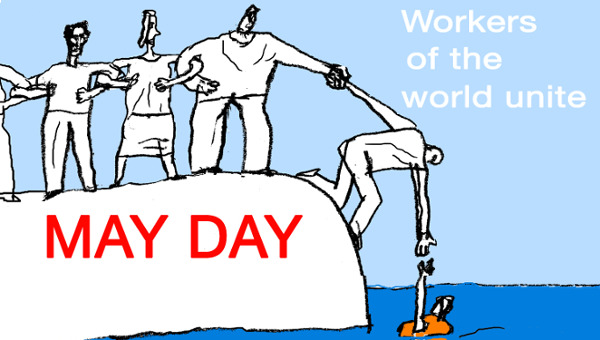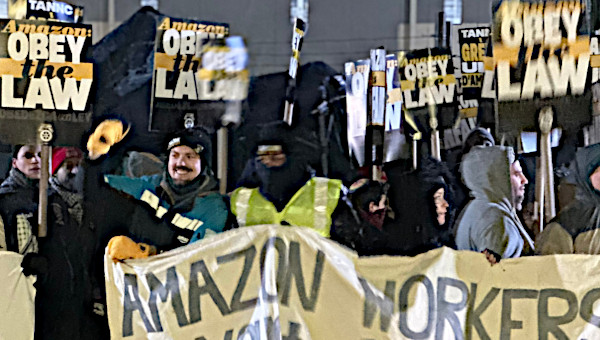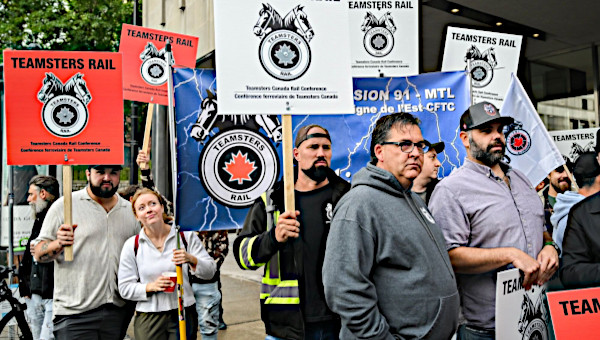Post-Strike Musings: Assessing the Outcome of the Museum Workers’ Struggle
On December 15th, after a strike lasting 86-days, PSAC workers voted to accept the tentative agreement reached between Public Service Alliance of Canada (PSAC) Local 70396’s bargaining unit and the Canadian Museum of Civilization Corporation (CMCC). The strike occurred after weeks of stalled negotiations resulted in an offer deemed unacceptable by 92% of the voting membership. According to a communiqué released by the CMCC’s chief communications office, the agreement reached by them and the PSAC workers reflect its “commitment to face-to-face discussions, compromise and mutual understanding.” Looking back at their enduring struggle for job security and fair wages throughout negotiations, employees may greet this statement with a difference of opinion. The strike ended in what many consider as a relative victory with gains in the protection of employees against the contracting out of positions; however, the road to success was a long and arduous one. A road made no easier to traverse by the actions, or rather the absence thereof, of the CMCC and its CEO, Victor Rabinovitch.
The CMCC maintains that despite the dispute and the striking workers outside, the Museums continued to be open to the public and provide cultural services throughout the strike to the “thousands of visitors” who crossed the picket line to enter. Victor Rabinovitch stated, “Now that the recent strike is behind us and a four-year agreement has been reached, staff and management can move forward with our common goal: the continued success and excellence of the Canadian Museum of Civilization (CMC) and the Canadian War Museum (CMW) as essential Canadian cultural institutions.” This statement does little to describe the real struggle that occurred in reaching that agreement or how uncooperative the Crown corporation was throughout the process.
Striking Against Casualization
One could argue that the goal of the CMCC was not only to continue the “success and excellence” of the Museums but to also continue the casualization of its labour force as well as reserve the right to fire them at will. In order to avoid waiting the mandatory ten minutes before crossing the picket line with his vehicle, Rabinovitch was said to park elsewhere and walk directly across the line en route to his office. He also left part-way through the initial negotiations to do business in Japan returning on September 22nd, one day after the strike had already begun. In his absence, the CMCC misled PSAC workers about the details of a proposed wage increase. The CMCC made it seem as though workers would receive a 15% wage increase, when in reality the offer was much more like 7% over four years. Of course, this actual offer would do very little to bring museum workers up to par with what workers at other comparable federal cultural insititutions are making.
The federal government did very little to intervene and put a stop to the stall tactics being used by the corporation. When the CMCC refused arbitration offered by the Minister of Labour, Rona Ambrose, the Minister did nothing to push the point even though the union had agreed to it. Negotiations finally resumed on December 11th 2009, but it took a meeting between Rabinovitch, PSAC president John Gordon, the Deputy Minister of Labour Canada, and a senior official of the Federal Mediation and Conciliation Service to make it happen.
In spite of the CMCC’s apparent unwillingness to take negotiations seriously, many improvements to the working conditions of its workers were won in the end. The main issue on the table was job security and the end of contracting out positions that at one time were, or could be made, permanent. Workers also called for the end of abusive hiring practises, arbitrary firing, and enforced precariousness endured by temporary employees at the Museums. In this, the workers were remarkably successful. New language has been introduced within the new collective agreement that guarantees no existing temporary position will be involuntarily eliminated as a result of the contracting out of the same position. However, the CMCC will now use attrition as a way of reducing staff instead of unjust termination. In instances of layoffs, the employee will be offered a severance, which both the employee and the union local must approve. Also, gained in negotiations are salary protections for those who are reassigned. As a step toward recognizing seniority among casual employees, the CMCC is offering seven newly created permanent part-time positions to be filled internally based on experience and years of service.
The workers also called for an end to the cruel termination of temporary workers days before they would qualify as permanent according to the collective agreement. The Museums have now agreed to provide full-time temporary workers with the opportunity of indeterminate status. However, this comes with the stipulation that their particular services are still required beyond 24 months. When new jobs become available internal applicants will be given preference provided they possess the necessary skills and seniority will be a factor in the hiring process. Also of importance are the improvements in maternal and parental leave benefits, which are now on par with the Quebec Parental Insurance program.
Building Rank and File Solidarity
What contributed to such a successful outcome? How was PSAC able to apply enough pressure to the CMCC and its stone-faced CEO to gain such advances? How did the workers so effectively fight for job security in the midst of a climate of economic insecurity? According to one employee, building solidarity among both the rank-and-file of the two museums and the executive played a major role in PSAC’s strength in maintaining their position. Feelings of camaraderie were fostered within the union consistently throughout the negotiating process. Regular updates were communicated to the membership by the negotiating team and the demands of the workers were presented in a clear and consistent way. Also, the Local received support from other Locals and was backed by PSAC’s main office. This culminated in the workers forming bonds on the picket lines and an affirmation by the vast majority of them to continue to fight to the bitter end. This dedication was evident in the refusal of the last offer made by the corporation toward the end of the strike, described as no better than their first, by 96% of the voting membership. Their resounding ‘no’ sent a clear message to the corporation that, even after 67 days of being on strike, workers remained fiercely united, were not prepared to back down, and were to be taken seriously. At this point it had to become quite clear to the CMCC that its attempts to outlast the picketers had failed.

Striking Treasures – The Exhibition.
Walking a picket line for weeks with no obvious end in sight can be extremely demoralizing; the financial and personal strain this puts on picketers can fracture a front line. Museum workers fought this by putting together regular cultural events that normally would have taken place inside the museum, but holding them outside instead. These events were open to the public and provided the workers with an opportunity to organize and work together on the picket line in a fulfilling way. The successful execution of the events, such as the one honouring veterans on Remembrance Day and the “picket line tea party” held in celebration of Prince Charles’ visit to Canada contributed in a substantial way to workers’ ability to maintain their spirits throughout the strike. The events also demonstrated the skill and creativity of workers to the public, as well as presented them as a valuable and productive force. This was especially clear when the Museum of Civilization opened the “Afghanistan: Hidden Treasures” exhibit and the workers created their own featuring themselves and entitled “Striking Treasures.” To quote one PSAC member, “We are project managers, special event organizers, public relations experts, exhibit preparators, and professional museum workers who present their leading-edge work on a regular basis not only to museum visitors, but in training programs, university courses, and conferences, all both nationally and internationally. Our strike response incorporated everyone’s knowledge and expertise.”
Holding events such as these on the picket line made workers extremely visible while maintaining professionalism. It encouraged dialogue between the picketers and the community, provided an opportunity for workers to express their legitimate concerns and reasons for being on strike, as well as garnered positive media attention and political support. Picketers were also visited by fellow artists and musicians – every bit of encouragement counted. Being able to attract the support of Members of Parliament including Marcel Proulx (MP Hull-Aylmer, Liberal Party) and Paul Dewar (MP Ottawa-Centre, NDP); the public; and other prominent figures such as Barry Blake (National Councillor for the Alliance of Canadian Cinema, Television and Radio Artists) and Douglas Cardinal (architect of the CMC), provided the workers with the leverage needed to resolve the lengthy dispute.
Of course, there are other aspects of the strike that were not quite so successful. What was more of a disappointment was with respect to their demand for wage parity with museum workers at other federal institutions, such as the Museum of Nature, and with good reason. It is with disgust that one considers Victor Rabinovitch has been reported as making 20% more than any other federal museum CEO in the Ottawa-Gatineau area, which translates into $236,000 yearly and bonus of up to $61,400, yet employees in the museums he administers continue to make up to 40% less than other employees with the same job titles and doing comparable work. This has understandably left a sour taste in the mouths of rank-and-file members.
Furthermore, although picketers were anxious to return to work, relations with management remain somewhat frosty and they find themselves presented with new challenges. For instance, some employees have returned to find scabs still working in the Museums, while others must now work alongside those who crossed the picket line. It does not appear that the CMCC has plans to become anymore worker friendly in the near future either. On December 18th 2009, the CMCC announced that Rabinovitch had been renewed as President and CEO until May 22nd 2011. Rabinovitch has since stated that during his time as CEO he plans to focus his energy on “new strategic objectives set out by the Board of Trustees,” which include “attracting private sector support to supplement government funding.”
Union Struggle Now Moves to
National Gallery of Canada
While facing unjustified layoffs of their own during the strike, PSAC members working for the National Gallery of Canada Corporation (NGCC) expressed solidarity during the strike and contributed $1000 to their sisters and brothers at the CMC and CWM. Gallery workers also stood beneath the giant spider in front of the Gallery to raise financial as well as moral support for their comrades. PSAC Local 70397’s collective agreement with the National Gallery of Canada (NGC) is set to expire in June of this year. In reflecting on the struggle of the museum workers, one cannot help but think of similar issues currently being faced by Gallery employees and wonder what kind of influence the recent strike will have on their outcome. Given the gains achieved by their colleagues at the Museums, it is likely to be a positive one. In addition, resistance to the recent cuts made to the arts by the Conservative government is expected to increase militancy among workers. Hopefully, Gallery employees will not be forced to resort to strike action in order to negotiate a fair collective agreement.
In light of the NGCC’s proposal to privatize its bookstore PSAC held meetings on November 20th 2009 in order to develop a strategy and explore legal options to ensure the their members’ rights are protected. PSAC also opposes the privatization of the bookstore, which the union maintains will result in nothing more for the Gallery than lost revenue and the dismissal of quality public sector employees. It is interesting to note that the CMCC had privatized an increasing number of positions during the time leading up to the strike including ticket agents, security guards, positions within the boutique and cafeteria. The proposal to privatize has actually come as a surprise for many considering its success and high revenues – to the tune of 26% of the Gallery’s total. Several questions have been hurled at Marc Mayer, National Gallery Director and the Board of Trustees with respect to this issue. In particular, what is the Gallery’s rationale behind privatizing such a substantial source of revenue and lay off every single educator guide, totalling 12 people, when it continues to provide managers with large bonuses?
The Gallery also plans to terminate an additional 9 employees once privatization has gone through as a means of trimming cost; however, what it is not planning to cut down on is Marc Mayer’s expense account, which has many workers outraged. Mr. Mayer has accumulated $76,000 in expenses, more than any other museum head, while others are laid off. Even Victor Rabinovitch fades in comparison with a mere $5783 for 2009. The Gallery insists that the Director cannot perform his job properly without indulging in executive travel and expensive lunch meetings. Of course, his incentive to do a good job is obvious, since it results in a 15% “performance award,” which raises his salary from $167,300 to $196,900 annually. Also, the Director insists that he tried to avoid layoffs in the face of dropping ticket sales, due to the economic downturns, by providing employees with the option to take either an unpaid leave or early retirement – two equally unattractive offers for a worker trying to hold on to her or his job.
The layoffs have also left many confused considering that, according to a study paid for by the NGC, educator guides are clearly “the single greatest factor in the success of a school tour.” Shortly following the dismissal of the guides, Gallery workers already began garnering support from fellow educators in the region by organizing a special free-admission event for them. The workers illustrated that visitors to the Gallery will essentially be “in the dark” now that the guides, who provided themed tours, workshops, and discoveries, were no longer there. Information pamphlets and flashlights were passed out with the message, “For the guideless tours at the NGC.” PSAC has proceeded to file grievances in light of the layoffs and points out that it is against the current collective agreement for the NGCC to outsource work that should be kept within the bargaining unit. Yet ironically, in light of all this, in their Human Resources Corporate Policy document, the NGCC states, “The Gallery values its workforce and creates a work environment in which people can maximize their potential and contribute fully to the success of the organization.”
Uniting Museum Workers
The federal government’s apparent refusal to consult with workers when making decisions on how Crown corporations ought to be managed and how their workers are to be treated is certainly troubling. Gallery workers are now getting ready to face the NGCC at the negotiating table and are committed to fighting for protections against lay-offs in the next contract. Maria Fitzpatrick, PSAC’s Regional Executive Vice-President for the Ottawa-Gatineau area expresses confidence in the Gallery workers’ ability to mobilize by saying, “We have two strong and determined PSAC locals at the CMC and NGC. The collective solidarity of the workers is essential to help those cultural institutions fulfil their cultural and socio-economic role in the national capital and in the country.” With this in mind, the president of PSAC Local 70396 Daniel Poulin, representing CMCC museum workers, stands in solidarity with NGC workers and calls for employees within all cultural institutions to do the same. To quote PSAC’s National President John Gordon: “When workers unite, anything is possible.” •





